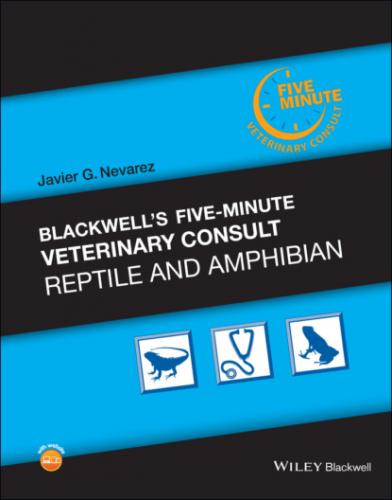COMMENTS
N/A
ZOONOTIC POTENTIAL
Herpesviruses of reptiles have not been shown to be zoonotic.
SYNONYMS
Fibropapillomatosis (FP) in sea turtles
ABBREVIATIONS
chHV5 = chelonid alphaherpesvirus 5
CNS = central nervous system
ELISA = enzyme‐linked immunosorbent assay
FPTHV = fibropapillomatosis‐associated turtle herpesvirus
HV = herpesvirus
LETD = lung = eye = and trachea disease
LEDV = lung = eye = and trachea disease virus
LGRV = loggerhead genital–respiratory herpesvirus
LOCV = loggerhead orocutaneous herpesvirus
PCR = polymerase chain reaction
POTZ = preferred optimal temperature zone
TeHV = testudinid herpesvirus
Suggested Reading
1 Gandar F, Wilkie GS, Gatherer D, et al. The genome of a tortoise herpesvirus (testudinid herpesvirus 3) has a novel structure and contains a large region that is not required for replication in vitro or virulence in vivo. J Virol 2015;89(22):11438–11456.
2 Marschang RE. Virology. In: Divers SJ, Stahl SJ, eds. Mader’s Reptile and Amphibian Medicine and Surgery. St. Louis, MO: Elsevier; 2019:247–269.
3 Marschang RE. Viruses infecting reptiles. Viruses 2011;3:2087–2126.
Author Rachel E. Marschang, PD, Dr. med. vet., DECZM (Herpetology), FTÄ Mikrobiologie
Hexamita
DEFINITION/OVERVIEW
Hexamita is a small flagellate parasite which can be found in the intestinal tract of chelonians and snakes. Hexamita parva is the usual cause of disease in chelonians. Disease has not been reported in other reptiles.
ETIOLOGY/PATHOPHYSIOLOGY
Infection is thought to occur by ingestion of an infective cyst, which passes into the gastrointestinal tract.
Reproduction is by simple binary fission. Subsequently, the parasite may ascend via the bile ducts to the gall bladder or via the ureters to the kidneys, where it encysts, resulting in inflammation.
Alternatively, Hexamita may pass through the gastrointestinal tract without resulting in disease.
Transmission can occur via urine or feces.
SIGNALMENT/HISTORY
Disease has been described in a wide variety of chelonian species with no “typical” signalment.
CLINICAL PRESENTATION
Animals with Hexamita infection may be asymptomatic or have non‐specific signs such as lethargy and reduced appetite.
If significant renal pathology is present, weight loss and polydipsia may be seen.
RISK FACTORS
Husbandry
Poor hygiene will increase the risk of disease transmission.
Others
Pre‐existing renal or biliary disease or concurrent parasite infection have been suggested to be potential risk factors.
Identification of the parasite in a sample of urine ± feces may lead to suspicion of disease, but flagellates are not always associated with pathology.
Definitive diagnosis requires detection of the parasite on renal biopsy in a live animal.
DIFFERENTIAL DIAGNOSIS
Parasites should be distinguished from commensal intestinal flagellates, especially trichomonads, which may commonly be seen in fecal samples or urine samples contaminated with feces.
DIAGNOSTICS
Analysis of a fresh urine sample may reveal small fast‐moving flagellates (< 8 microns) characterized by six anterior flagella.
In small samples the parasite will rapidly desiccate and die.
Renal biopsies should be submitted for histopathology.
Biochemistry may be helpful to indicate degree of renal damage.
PATHOLOGICAL FINDINGS
Characteristic postmortem findings include pale enlarged kidneys with dilated collecting tubules. Bile ducts appear thickened with a dilated lumen.
On histopathological examination, flagellates may be visualized within the renal tubules and bile ducts with associated inflammatory changes.
APPROPRIATE HEALTH CARE
Treatment involves both eliminating the parasite and supportive care of the renal disease.
Euthanasia may be considered in severe cases of renal failure.
NUTRITIONAL SUPPORT
Some patients may be anorexic and severely dehydrated on presentation.
Fluid deficits should always be corrected and nutritional support provided as needed.
CLIENT EDUCATION/HUSBANDRY RECOMMENDATIONS
Hygiene measures should be reviewed to minimize the risk of disease transmission.
DRUG(S) OF CHOICE
Metronidazole is the most common choice for treating Hexamita.
Various
